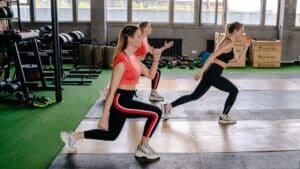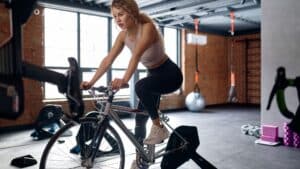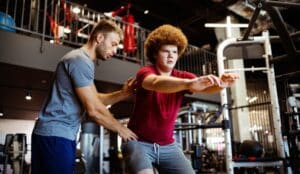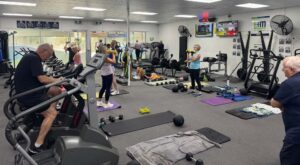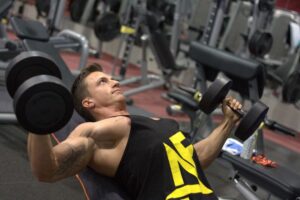Welcome to “The Ultimate Guide to Step Exercises: Boosting Fitness and Burning Calories”! Are you ready to take your fitness journey to new heights? Whether you’re a seasoned athlete looking to spice up your routine or a fitness newbie eager to explore fun and effective workouts, step exercises are an incredible way to achieve your goals.
Step exercises offer a unique blend of cardiovascular conditioning, muscle strengthening, and calorie burning, all while providing an engaging and dynamic experience. From stepping up and down on a simple platform to performing intricate choreographed routines, this comprehensive guide will walk you through the ins and outs of step workouts.
let’s lace up our sneakers, grab our step platforms, and dive into this ultimate guide, where we’ll uncover the secrets to boosting your fitness levels and torching calories with the power of step exercises. Are you ready to step up and transform your body? Let’s begin the journey!
The Benefits of Step Exercises
Step exercises offer a wide range of benefits that make them a fantastic addition to any fitness routine. From cardiovascular health to muscle tone and coordination, here are some of the key advantages you can reap from incorporating step exercises into your regimen:
Cardiovascular Conditioning: Step workouts are excellent for improving cardiovascular health. The rhythmic and repetitive movements elevate your heart rate, leading to better circulation, increased lung capacity, and enhanced overall endurance.
Calorie Burning: If you’re aiming to burn calories, step exercises are your ally. The dynamic nature of stepping, combined with the intensity you can achieve, makes it an effective way to shed those extra pounds and maintain a healthy weight.
Leg Strength and Muscle Tone: Step exercises target your lower body muscles, including your quadriceps, hamstrings, calves, and glutes. Consistent step workouts help build strength, tone these muscles, and contribute to a well-defined lower body.
Improved Coordination: Stepping up and down a platform challenges your coordination and balance. Over time, this can lead to improved motor skills and better overall body control, reducing the risk of falls and injuries.
Enhanced Core Engagement: A stable core is essential for good posture and overall strength. Many step exercises require balance and stabilization, which engage your core muscles, helping you develop a strong and supportive midsection.
Versatility: Step exercises can be as simple or as complex as you want them to be. Whether you’re a beginner or an experienced athlete, you can adjust the height of the platform, the complexity of the routines, and the pace of the workout to suit your fitness level and goals.
Fun and Engaging: Step workouts are known for their fun factor. The combination of music, choreography, and the feeling of accomplishment as you master new routines makes it an enjoyable way to stay motivated and committed to your fitness journey.
Low-Impact Option: Step exercises can be a fantastic low-impact alternative for those seeking a cardio workout without putting excessive stress on their joints. It’s particularly beneficial for individuals recovering from injuries or looking for a gentler form of exercise.
Mental Benefits: Exercise is not just about physical health; it’s also great for your mental well-being. Step workouts release endorphins, the “feel-good” hormones, which can help reduce stress, anxiety, and improve your overall mood.
With these incredible benefits, step exercises have something to offer everyone, regardless of their fitness level or goals. So why wait? Start stepping your way to a healthier, fitter you today!
Why we should do Step Exercises?
Embracing step exercises is a decision laden with transformative potential for both our physical vitality and mental well-being. These exercises fuse the exhilaration of cardiovascular fitness with the subtlety of muscle toning, offering an efficient means to elevate our heart rate and torch calories. As a low-impact endeavor, step exercises stand as an inclusive option, accommodating various fitness levels and ensuring joint health. They empower us with improved coordination, balance, and functional fitness, empowering us to move gracefully through our daily activities. The diverse array of step workout styles keeps exercise exciting and dynamic, and the positive social environment in many step classes can enhance our motivation to stay active. Moreover, the mental upliftment fostered by step exercises, with the release of endorphins and stress reduction, contributes to a heightened sense of well-being. Whether we’re seeking a more toned physique, an enhanced cardiovascular system, or a lively and engaging way to stay fit, stepping into the world of step exercises is a step in the right direction, guiding us towards a healthier and happier lifestyle.
The Ultimate Guide to Step Exercises
Welcome to “The Ultimate Guide to Step Exercises” – your comprehensive resource for unlocking the secrets of an incredibly effective and dynamic fitness approach. Whether you’re a fitness enthusiast looking to spice up your routine or someone just beginning their fitness journey, this guide is designed to empower you with the knowledge, techniques, and motivation to step up your fitness game.
The Foundations of Step Exercises
In this chapter, we’ll start by laying the groundwork. Discover the history and evolution of step exercises, learn about the equipment you’ll need (hint: a step platform), and understand the science behind why step exercises are so impactful. We’ll also address common misconceptions and provide you with the motivation to get started.
Stepping Up: Mastering the Basics
Before we dive into the exciting routines, it’s essential to master the fundamental techniques. Learn the proper step movements, understand how to set up your step platform, and grasp the importance of maintaining proper form. This chapter ensures you have a solid foundation to build upon.
Step by Step: Basic Exercises
Now the real fun begins! Explore a variety of basic step exercises that target different muscle groups while getting your heart pumping. These exercises are suitable for beginners and provide a fantastic starting point to build your strength and endurance.
Elevating Your Routine: Intermediate Step Exercises
Ready to challenge yourself? In this chapter, we’ll introduce you to more complex step exercises that take your fitness journey to the next level. These exercises incorporate creative choreography and intensify your workout, helping you burn more calories and tone your body.
Beyond the Platform: Advanced Step Workouts
For those seeking the ultimate fitness experience, we’ll explore advanced step workouts that push your limits. Discover high-intensity routines, dance-based step exercises, and ways to incorporate step workouts with other forms of training. Prepare to be amazed by what your body can achieve.
Crafting Your Step Exercise Plan
To wrap up your journey, we’ll guide you in creating a personalized step exercise plan that aligns with your goals, fitness level, and schedule. We’ll also provide tips on staying motivated and overcoming challenges, ensuring that step exercises become a sustainable and enjoyable part of your life.
Get ready to elevate your fitness, boost your energy, and unleash the potential of step exercises. Let’s embark on this exciting adventure together, one step at a time!
Types of step exercises
Step exercises come in a diverse array of styles, each offering unique challenges and benefits. From the basics to the more advanced, let’s explore the exciting world of step workouts:
High Knee March
The high knee march is a simple yet effective exercise that engages your core, strengthens your lower body, and gets your heart rate up. It’s a great warm-up exercise before a workout or as a standalone cardio move. Here’s a step-by-step guide on how to perform the high knee march:
1. Stand Tall: Begin by standing up straight with your feet hip-width apart. Engage your core muscles by pulling your belly button in toward your spine.
2. Start Marching: Lift one knee as high as you comfortably can while balancing on the opposite leg. Your thigh should be parallel to the ground or as close to it as possible. Keep your foot flexed so your toes are pointing upward.
3. Alternate Legs: Lower the lifted leg back down while simultaneously lifting the opposite knee. Keep the motion controlled and deliberate, focusing on proper form and balance.
4. Swing Your Arms: As you march, swing your arms in coordination with your legs. When you lift your right knee, swing your left arm forward, and vice versa. This natural arm movement adds to the cardiovascular benefits of the exercise.
5. Maintain a Steady Pace: Aim for a consistent pace as you march. You can start with a slower pace and gradually increase the speed as you feel more comfortable.
6. Keep Your Core Engaged: Throughout the exercise, focus on maintaining a stable core. This not only helps with balance but also works your abdominal muscles.
7. Land Softly: As you lift each knee, make sure to land gently on the ball of your foot. This reduces impact on your joints and allows for a smooth, controlled movement.
8. Breathe: Don’t forget to breathe! Inhale and exhale naturally as you march. Breathing rhythmically helps to oxygenate your muscles and keep your energy levels up.
9. Duration: Aim for at least 1-2 minutes of high knee marching to get your heart rate up and your body warmed up. You can also incorporate high knee marches into your cardio routine by doing sets of 30 seconds to 1 minute with short breaks in between.
10. Cool Down: After you’re done with high knee marches, make sure to cool down with some gentle stretching to prevent muscle tightness.
Remember, proper form is essential for getting the most out of this exercise and preventing injury. Start at a pace that feels comfortable for you, and as you become more familiar with the movement, gradually increase the intensity. Incorporating high knee marches into your fitness routine can be a fantastic way to boost your overall cardiovascular fitness and get your body moving!
Low Step-Ups
Low step-ups are a fantastic lower body exercise that targets your quads, hamstrings, glutes, and calf muscles while also improving balance and stability. Whether you’re a beginner or looking to add some variety to your leg workouts, low step-ups are a great option. Here’s a step-by-step guide on how to perform low step-ups:
Equipment Needed: For this exercise, you’ll need a sturdy platform or step that is low in height. A step or bench around 6-12 inches off the ground is ideal.
1. Position Yourself: Stand facing the step with your feet about hip-width apart. Keep your posture upright, shoulders relaxed, and engage your core muscles.
2. Step Up: Lift one foot off the ground and place it firmly on the step. Ensure that your whole foot is on the step, not just the toes or the edge. Your foot should be centered.
3. Step Up Completely: Shift your weight onto the foot that’s on the step and straighten that leg as you lift your other foot off the ground.
4. Fully Extend: Stand tall on the step, fully extending your hip and knee. The leg that’s on the step should support your body weight.
5. Controlled Step Down: Lower your lifted leg back down to the ground, returning to the starting position.
6. Alternate Legs: Repeat the same process with the opposite leg. Step up with the other foot, fully extend, then step back down.
7. Proper Form: Keep your movements controlled and avoid using momentum. Focus on using the muscles of your legs to lift your body weight, not your back or upper body.
8. Breathing: Exhale as you step up and inhale as you step down. Breathing rhythmically helps maintain your focus and ensures proper oxygenation of your muscles.
9. Number of Reps and Sets: Start with a manageable number of repetitions, such as 10-12 reps per leg. You can perform 2-3 sets, resting for 30-60 seconds between sets.
10. Safety: Ensure that the step or platform you’re using is stable and won’t slide or move during the exercise. If you’re new to this movement, you can practice with just your body weight before adding additional weights.
11. Cool Down: After completing your sets, take a few minutes to stretch your leg muscles to prevent tightness.
Low step-ups are a versatile exercise that can be adapted to various fitness levels. If you’re a beginner, you can start with bodyweight-only step-ups, and as you get more comfortable, you can gradually increase the height of the step or add weights for more resistance. This exercise is not only effective for building lower body strength but also for improving functional fitness, making it an excellent addition to your workout routine.
Box Squat Jump
Box squat jumps are an explosive plyometric exercise that targets your leg muscles while also improving power and vertical jump. They’re excellent for developing lower body strength, speed, and explosiveness. Here’s a step-by-step guide on how to perform box squat jumps safely and effectively:
Equipment Needed: You’ll need a sturdy box or platform that is about knee height. Ensure that the box is stable and won’t move during the exercise.
1. Stand in Front of the Box: Position yourself in front of the box with your feet shoulder-width apart. Your toes should be pointing forward.
2. Squat Down: Begin by performing a standard squat. Lower your hips back and down, bending your knees while keeping your chest up and your back straight. Your thighs should be parallel to the ground or slightly below.
3. Explode Up: From the squat position, engage your leg muscles and explosively jump up off the ground. As you jump, extend your hips, knees, and ankles fully.
4. Land on the Box: As you reach the peak of your jump, aim to land softly on top of the box or platform. Land with your feet flat, ensuring that your whole foot is on the box. This helps prevent excessive stress on your knees and ankles.
5. Control the Landing: Upon landing on the box, immediately absorb the impact by bending your knees slightly. This controlled landing is essential to reduce the risk of injury.
6. Step Back Down: After landing on the box, step back down to the starting position. You can step down one foot at a time or hop down if you’re comfortable with it.
7. Rest and Repeat: Take a brief rest, then perform the next repetition. Aim for a set number of repetitions, such as 8-10 reps to start. You can perform multiple sets, but ensure you have adequate rest (about 1-2 minutes) between sets.
8. Breathing: Exhale as you jump and inhale as you land and step back down. Breathing rhythmically helps maintain your focus and control.
9. Proper Form: Focus on using your leg muscles to generate power, and maintain a straight back throughout the movement. Avoid rounding your back or leaning forward.
10. Warm-up: It’s essential to warm up your muscles before attempting box squat jumps. Perform some light cardio and dynamic stretches to get your body ready.
11. Safety: Start with a lower box height, and as you become more comfortable and proficient, you can increase the box height for a greater challenge.
Box squat jumps are an advanced exercise, so ensure you have a good foundation of strength and proper squat form before attempting them. They can be an excellent addition to your plyometric or lower body training routine to enhance explosiveness and overall athletic performance.
Centre Hop and Squat
The center hop and squat exercise is a dynamic movement that combines a lateral hop with a squat, working multiple muscle groups and enhancing cardiovascular fitness. This exercise is great for improving agility, lower body strength, and coordination. Here’s a step-by-step guide on how to perform the center hop and squat:
1. Stand Upright: Start by standing with your feet together and your arms by your sides. Engage your core muscles to maintain stability throughout the exercise.
2. Perform a Squat: Begin by squatting down, pushing your hips back as if you’re sitting in a chair. Keep your chest up and your back straight. Lower yourself until your thighs are at least parallel to the ground or slightly below.
3. Hop to the Side: From the squat position, explosively jump to the side, pushing off with both feet. Aim to jump horizontally, not too high but far enough to feel a challenge.
4. Land in a Squat: As you land, immediately go back into a squat position. This ensures that you absorb the impact of the landing and maintain proper form.
5. Center Squat: From the squat position, jump back to the center, returning to the starting position. This completes one repetition.
6. Alternate Directions: For the next repetition, hop in the opposite direction, maintaining the same form—squat, hop, squat, center. Repeat this sequence for the desired number of reps.
7. Breathing: Exhale as you jump and inhale as you land and squat. Consistent breathing helps you stay focused and maintain the rhythm of the movement.
8. Number of Reps and Sets: Start with a moderate number of repetitions, such as 8-10 reps per side, to get the hang of the movement. You can perform 2-3 sets, resting for 30-60 seconds between sets.
9. Safety: Ensure you have enough space around you to perform the lateral hop without obstacles. It’s important to land softly to protect your joints, and as with any exercise, maintain proper form to prevent injury.
10. Warm-up: Like any dynamic exercise, it’s essential to warm up your muscles before attempting center hop and squats. Perform some light cardio and dynamic stretches to prepare your body.
The center hop and squat exercise adds an element of fun and challenge to your workout routine while targeting your legs, core, and even improving your cardiovascular fitness. As you become more comfortable with the movement, you can increase the intensity by hopping farther or adding weights for resistance. This exercise is great for building athleticism and can be a valuable addition to your overall fitness program.
Side Steps and High Kicks
Side steps with high kicks is a dynamic exercise that combines lateral movement with high kicks, engaging your leg muscles, improving flexibility, and elevating your heart rate. This exercise is excellent for warming up, enhancing lower body strength, and increasing range of motion. Here’s a step-by-step guide on how to perform side steps with high kicks:
1. Stand Upright: Begin by standing tall with your feet together and your arms relaxed by your sides.
2. Side Step: Take a step to the side with your right foot, leading the movement. Shift your weight to the right foot and bring your left foot to meet the right foot.
3. High Kick: After completing the side step, lift your left knee up towards your chest. As you extend your left leg, kick it out to the side as high as comfortably possible. Engage your core to maintain balance.
4. Step Down: After the high kick, lower your left leg back down to the ground and place it next to your right foot.
5. Alternate Sides: Repeat the same sequence on the other side. Take a step to the left with your left foot, then perform a high kick with your right leg.
6. Rhythm: Continue alternating sides, moving in a rhythmic fashion. Focus on maintaining a steady pace, keeping the movement controlled and deliberate.
7. Arms: Coordinate your arms with the movement. As you step to the side, swing your arms gently in the direction of the step. As you perform the high kick, extend the opposite arm in the same direction to balance the movement.
8. Breathing: Exhale as you perform the high kick and inhale as you step to the side. Consistent breathing helps you stay focused and maintain the rhythm of the exercise.
9. Number of Reps and Sets: You can start with a moderate number of repetitions, such as 10-12 reps per side. Perform 2-3 sets, resting for 30-60 seconds between sets.
10. Safety: Maintain proper form and control throughout the movement to avoid overstretching or losing balance. Perform this exercise in an open space to prevent obstacles and ensure you have enough room to move laterally.
11. Warm-up: As with any dynamic exercise, it’s essential to warm up your muscles before attempting side steps with high kicks. Perform some light cardio and dynamic stretches to prepare your body.
Side steps with high kicks are not only a great exercise for the lower body but also a fun way to improve flexibility and coordination. This exercise can be incorporated into your warm-up routine or used as a standalone cardio move. As you become more comfortable, you can increase the intensity by increasing the height of the kicks or the speed of the movement.
Explore these various types of step exercises to find the ones that align with your fitness goals and preferences. Whether you’re aiming for an intense cardiovascular workout, muscle toning, or a dance-infused experience, there’s a step exercise style that’s perfect for you. Keep things exciting by trying different styles, and you’ll never get bored with your fitness routine!
Conclusion
As we wrap up this exploration of step exercises, let’s carry forward the enthusiasm, the knowledge, and the motivation we’ve gained. Let’s continue stepping up, stepping forward, and stepping into the best versions of ourselves. Whether it’s a simple step or a challenging routine, every step we take is a step towards a healthier, stronger, and more vibrant life. So, let’s keep stepping, one step at a time, towards a brighter and healthier future. Remember, the journey is in the steps we take, and the rewards are in the progress we make. Keep stepping, and keep thriving!

